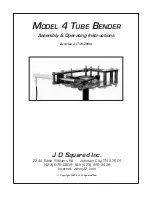
®
M o d e l N o . W A - 9 8 9 7
S e t u p
3
Ripple Tank Assembly
The ripple tank assembly has an impact resistant plastic frame.
Below the front edge of the frame is a strip of Velcro® ‘hook’
material that will hold the ‘loop’ material on the top edge of the
projector screen. Below the back edge of the frame are three
pegs that fit into the holes in the top edge of the reflector. The
threaded hole on the top side of the back edge is for the rod that
can support the Light Source that is included in the WA-9896
Ripple Generator and Light Source. When the ripple tank is in
use, the four foam ‘beaches’ dampen the waves that would oth-
erwise reflect and disturb the primary wave and interference
patterns. The foam beaches are replaceable. (A variety of
replacement parts are available in the WA-9898 Ripple Tank
Replacement Set.)
The ripple tank’s drain pipe is a piece of flexible vinyl tubing
attached below the drain hole at the back corner of the tank. Squeeze the sides ot the tube clamp on the
drain pipe to tighten the clamp on the tubing. Pull downward on the lip of the tube clamp to loosen the
clamp.
Setup
To setup the ripple tank, screw the legs into the threaded holes on the underside near the two front corners
of the tank, and under the midpoint of the back edge. Place the ripple tank on a smooth, level surface.
To attach the reflector and projection screen to the tank, unfold the screen assembly and put the reflector
between the two front legs. Angle the reflector upwards and guide the top edge so that the three holes fit
over the pegs that are at the back edge of the tank. Next, raise the projection screen to the vertical position
and attach its Velcro® ‘loop’ material to the strip of ‘hook’ material under the front edge of the tank.
Apply Surfactant
Before putting water into the ripple tank for the first time, prepare the foam
beaches, barriers, and refractors with a drop of surfactant (a nonionic wetting agent). The surfactant helps to
avoid problems with the surface tension of the water. Put a single drop of surfactant from the small plastic
bottle onto the end of one finger, and lightly rub your finger along the foam beaches. Use a single drop of
surfactant to very sparingly coat the large flat surfaces of the three refractors and the front surfaces of the
straight and curved barriers. Note that you only need to apply surfactant to the beaches, barriers, and refrac-
tors before using the ripple tank for the first time, or if the equipment has been unused for a long time.
Level the Ripple Tank
When you are ready to add water to the tank, squeeze the sides of the tube
clamp to close the clamp. Use the beaker to add a small amount of water to the middle of the tank so that the
water forms a circle about 10 cm in diameter. Adjust the feet on the legs until the circle of water stays in the
middle of the tank and does not move toward any side. (An alternate method for leveling the tank is to add
about 800 milliliters of water to the tank. Measure the water depth at three of the four corners of the tank and
adjust the feet on the legs until the depths are the same.)
Dampen the Foam Beaches
To reduce the problem of surface tension, let the foam beaches soak
up some of the water. After putting about 800 milliliters of water in the tank, press down on the foam and
then release the pressure so that water enters the pores of the foam rubber.
Cleanup
Before emptying the tank, remove the projection screen and reflector. Fold the screen assembly so the pro-
jection screen protects the reflector.
Drain hole
Threaded hole
Pegs
Strip of Velcro® ‘hook’
material (not shown)
Squeeze
to tighten
Pull to
loosen





























